home > cflow journal > issues > archive 2006
cflow journal [2006-04-21]
“You broke through the humor of my little theater and tried to make a mess of it, stabbing with knives and spattering our pretty picture-world with the mud of reality.” – writes Hermann Hesse, defined by critics as the first pop novelist, in his novel “Steppenwolf.” In which the literary hero, a fair example of uncertain identity, a hybrid case – half human, half wolf –, introduces his dizzied antagonist, the tamed anti-hero and narrator of the story
to the
Dizzyland
“Dizzyland” (the land of dizziness, but also an allusion to Disneyland), the first edition of the video prize initiated by the Kuratorium of the Canton of Aargau, is not just “On Mice and Men,” but beyond that on mice and cats, other heroes and anti-heroes in a Theater of the Absurd in which animals, people, ghosts and cartoon characters all play their tragic but comical roles – cleverly toying with the title of what has emerged as the super-event of the year: the 4th Berlin Biennale. One day after its official opening on 11 March 2006, although in Baden, not Berlin, in the Canton of Aargau, Switzerland, at a night-filling party the final selection of the winners of the video contest took place – a video contest open to artists living in Switzerland. The dizzying contest does not merely indulge in a wave of hallucinogenic nightmares aroused by universal fears, but also in mawkifying and kitschifying, in the comical, the stupid as an inescapable part of the entertainment industry, “this imperialist stupefying machine shaken more and more by the diminished enthusiasm of the public the rising skepticism,” as writes the curator of the event, Oliver Kielmayer, in his curatorial statement.
In collaboration with the curator, the Expert Committee on Visual Art of the Kuratorium of the Canton of Aargau picked 18 short video pieces out of the 93 submitted to go into the final selection by a jury at a live event in the Nordportal Baden. The selection gives the impression of a witty thematic curatorial package of video shorts, which indeed it has turned into with its publication on DVD. Despite covering a wide spectrum of approaches and technical knacks, the video works strangely concur to develop a common theme with a similar sensitivity. Ranging from generated moving images based on 3D technology, documentary, experimental films, capture of stolen images, various mixes, all these expressions on the basis of moving pictures stay outside of any formal management of narratives in order to create reality. It is not their aim to imitate reality in order to interpret the world. The selection points to the current tendency of art to focus once more on its own inner narratives, to take a renewed interest in format, object, perspective or subject-matter. The 18 video shorts exhibit dreams and hallucinations, bold fantasy and stupid situations, merry nightmares with annual fair aesthetics, the effect of magic mirrors and merry-go-rounds, hocus-pocus, fakes, imitations, tricks. We come across displaced perspectives, lampoon, everyday objects in the process of their fabrication, or the destruction of the original, script and story. Apocalyptic or apolitical – at the same time superficial, capricious, biting, entertaining. They fascinate and bewitch, deceive.
With its exclusive topic touching on contemporary fluxes, with its good curatorial platform, convincing selection of works and attractive prizes, Dizzyland promises to occupy a place of choice in the Swiss event landscape in the field of contemporary art.
Impressive, and one could say objective, is the decision of the jury to award the first prize of 12’000 Swiss Francs to Margot Zanni for her video “Alice”, 2004, 2:00. At first glance this video does not offer anything special – just the slow appearance of an image. But precisely therein lies its great achievement. This very simple video film relies on the very clear idea to categorically refuse a narrative, and on its strength in stopping the perception of the dynamic of time. It proposes an exploration of the origin of images and correspondingly the return and renewed discovery of the object. A shot on the surface of slowly emptying water in a tub through which little by little the contours of the object become recognizable. Veiled in secrecy at first – the mysterious frightens. But it also seduces and ignites fantasy. It gets the consciousness to hallucinate, itself to imagine the object. The author continues to play with stereotypes, and the viewer is left to compile alone, if they so wish, their own version of a possible story. Here’s mine: it’s the moment of falling in the rabbit hole, and her braid is still looking out and is about to follow inside any moment. Nothing of the kind! This is not the hole in reality that swallowed Alice, but just the hair of a girl of the same name cut off, a braid whose one end is lying in the drain of a completely normal bathtub?
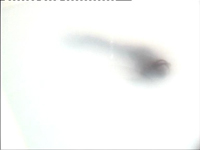


Stills from Margot
Zanni, “Alice”, 2004, 2:00. © 2004 Margot Zanni.
The second prize, of 7’000 Swiss Francs, goes to Clare Goodwin, with “The game of cards (A scene from Barry Lyndon)”, 2005, 5:00, made in collaboration with British artist Paul Harper. The video is an anti-technological piece, focusing on detail, drawing on the novel by William Makepeace Thackeray, famous for his opposition to the literary construction of the ideal hero and the insipid kitsch and the mannered hypocrisy of the Victorian age. Thackeray’s complex treatment of Barry Lyndon’s immorality on the background of the norms of society caught the interest of Stanley Kubrick, who turned the story into one of his masterpieces in 1975. How does Clare Goodwin deal with this weighty legacy? With irony and deceit. She does not depart from her very own style, in which through different surfaces, textures and backdrops, through deliberately sham props, she creates confusion and brings up absurd situations. A pompous textual introduction sets the stage for a parody of a puppet show in which the play is reduced to a minimum. The characterizing and context are achieved through manipulations of space, through the various “authentic” materials of the backdrops. She plays with the notion that nothing is forever, that colors change in life like in a game of cards. It can bring you to the top one day, and the next you may end up in the mud. Or vice versa.
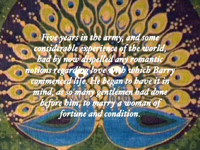
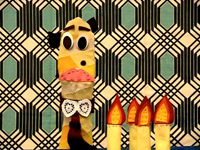

Stills from Clare
Goodwin, “The game of cards (A scene from Barry Lyndon)”,
2005, 5:00. © 2005 Clare Goodwin.
The jury gave the third prize, of 3’000 Swiss Francs, to Rudolf Steiner for “Tom + Jerry revisited for Dizzyland,” 2006, 3:54. A fascinating video story of violence. It calls forth contradictory feelings, but this is always the case when we are faced with violence and its artistic re-creation. Violence has been an important and inspiring element in most of the subjects in the European religious artistic tradition, and has fascinated and secretly titillated the passions of the public by offering a view on a bitterly voluptuous secret sensation of destruction, doom and decomposition of matter, from Salome kissing the beheaded face of John the Baptist to the suffering of Saint Sebastian. In contrast to this, violence in the contemporary entertainment industry is presented one-sidedly, literally and cursorily in its non-bloody and caricatured parodical cheerful cartoon scenes, or all too bloody and detailed in thrillers. “Tom + Jerry revisited for Dizzyland” in its own right occupies the parodical atmosphere of a bloody trash thriller, while at the same time it can be perceived as a documentary reportage full of black humor, an artistic diary of what your favorite pet does with those sweet little mice. In contrast to the legendary original serial cartoon by Hanna and Barbera of MGM Studios, where in the constant melee the little mouse wins the battle, in “real” life the truth is entirely different. Making use of the original soundtrack of the famous animation film and minimalist animation reduced to two playful points oscillating between white and black, a clever editing playing with the planes in an allusion to cartoon, this aestheticized bloody, but nonetheless real carnage of dissected mouse parts, nibbled-off paws, guts licked clean, blood-stained heads ripped off represents a detailed catwalk of brutal drawings of life – everyone is someone else’s food. I am however asking myself whether there will be an Episode II, a visual exploration, a study on a variation in which cats are hit by their most stupid and most frequent of deaths in the life of an average cat in a highly developed country, in which besides aromatic lawns filled with sweet little mice there are monstrous automobiles and numerous highways. This proposal is not a call for vengeance or a wish for fairness, but hey, we need to stay real.
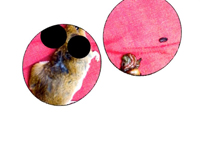
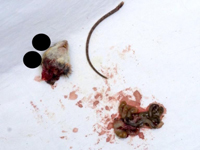
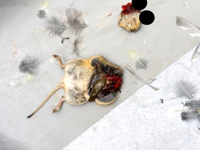
Stills from Rudolf
Steiner, “Tom
+ Jerry revisited for Dizzyland”, 2006,
3:54. © 2006 Rudolf Steiner.
A few of the works that ended up not winning a prize seem worth mentioning.
Bettina Disler, Behind the curtain, 2006, 2:10. A black and white film, at first glance inhabited by the fears of childhood, although I’d suggest making a bold link with the beginning of the history of cinema, where an excited crowd of spectators were entertained with all these emerging shadows – of stiffening fear and expression of horror – a frozen scream of “shrieking” hysterical beauties of mute films – from the first version of Nosferatu to Bluebeard. That archetypal fear – the cow’s eye in “An Andalusian Dog.” An interesting experiment aptly mixing disco effects with classical aesthetic in order to feed the imagination. The intensiveness and density of these two minutes give a glimpse of the great potential of the author.
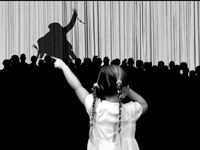
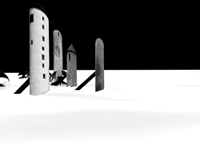
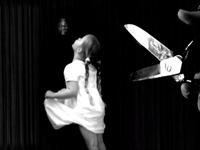
Stills from Bettina Disler, Behind
the curtain, 2006, 2:10. © 2006
Bettina Disler.
Thomas Galler, Inches, 2005, 5:04. With its bold appropriation and simple superposition of two excerpts, one sound – the pre-game speech of an American football coach to his team about winning –, the other moving images – shots of soldiers –, from commercial products of the Hollywood industry, it points to the other side of the coin of capitalism, with its real games of war, imperial, about petrol, money and muscle, but also the dirty games in sports around the commodification of athletic masculinity and the laundering of money. It is the only film in the package with a clear critical political message and gender approach. The two excerpts seem to be taken from one and the same context, but their superposition displaces the perspective. Through the discrepancy between sound and images, Thomas Galler introduces an ironic element that defuses the literal speech on male solidarity and heroism.

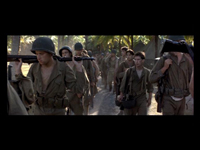
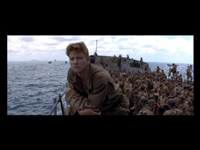
Stills from Thomas
Galler, “Inches”, 2005, 5:04. © 2005 Thomas
Galler.
The definitions of art by Yuri A also make a strong impression: Kunstdefinitionen, 2004, 5:11. Five people, a Swiss, a bodybuilder, an art collector, a museum curator and a blind artist, present their quite different views on what is art.
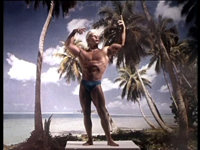
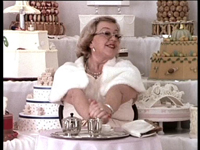
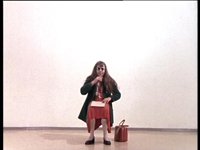
Stills from Yuri A, “Kunstdefinitionen”, 2004, 5:11. © 2004 Yuri
A
Anina Schenker, “Durch den Wind”, 2004/06, 6:00. No morphing involved, but rather a session in the windtunnel of the Sauber Formula 1 team. An experiment in which the extreme exposure to wind speeds beyond 200 km/h opens up more psychological possibilities for the images.


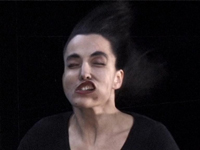
Stills from Anina
Schenker, “Durch den Wind”, 2004/06, 6:00. ©
2006 Anina Schenker.
Last but not least, it is Marianne Halter and Susanne Hofer, with “Home improvement,” 2004, 5:00, who walk away with the Audience Prize, of 5’000 Swiss Francs. This orderly world to the taste of the middle class falls apart, fragments itself under the weight of its own tastelessness, impossibility and synthetic order of old-fashioned artificial norms. After the absurd and comical attempts of the two authors to clean out, to rearrange, to ventilate, to fix this world with old materials, they just drive off from the place of the incident, the scene, the frame in the manner of Max and Moritz.
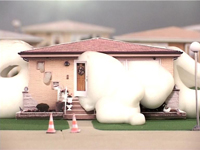

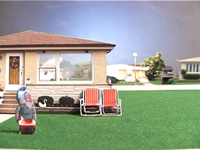
Stills from Marianne
Halter and Susanne Hofer, “Home improvement,” 2004,
5:00. © 2004 Marianne Halter and Susanne Hofer.
If you'd like a rather different view on the same event, you are welcome to consult the next issue of WeAreTheArtists (May 2006) and look for the text “Dizzyland - exercice de style” by code flow (somewhat incognito, without its title, but rather under the heading “Update: Baden” on the first page).